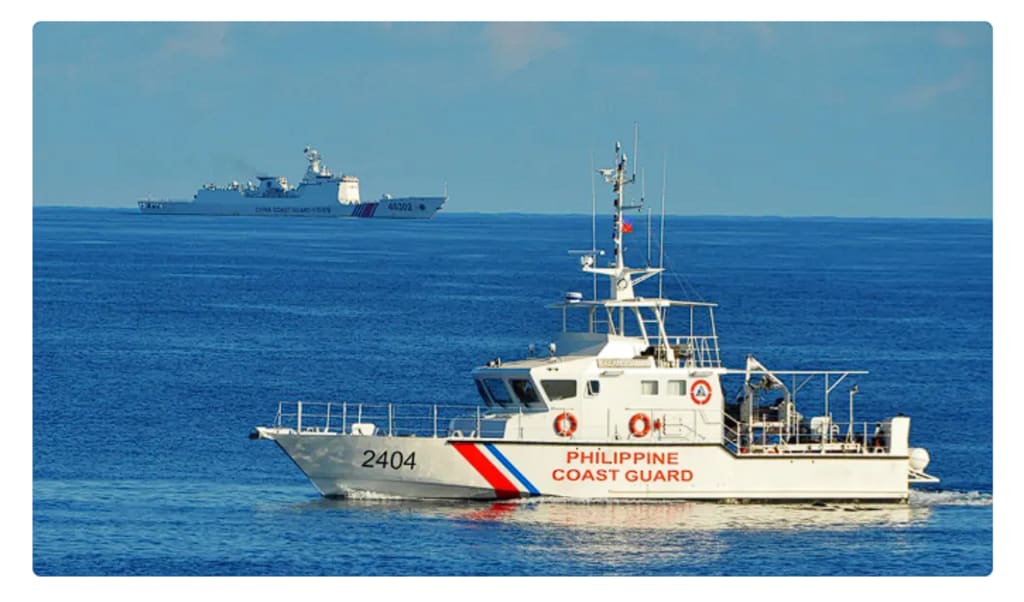Within less than 72 hours of the new regulations of the China Coast Guard taking effect, the Philippines had a collision with Chinese vessels at the Ren'ai Reef.
ahong

As the Chinese side's countermeasures were just announced, the Philippines took action on three fronts, provoking incidents in the Scarborough Shoal, the Ren'ai Reef, and other directions. Recently, at a press conference of the Ministry of National Defense of China, spokesman Senior Colonel Zhang Xiaogang answered reporters' questions on recent military-related issues, once again emphasizing that the Nansha Islands are inherent territory of China, and the Chinese side will take all necessary measures to resolutely counteract the dangerous actions by the Philippines to escalate the situation.
However, less than 24 hours after China issued a warning, the Philippines dispatched a vessel to intrude into the Huangyan Island. According to multiple foreign media reports, on the afternoon of June 14, a 44-meter patrol boat from the Philippine Coast Guard intruded into the southeast waters of Huangyan Island, China, and was intercepted by the Chinese Coast Guard about 23 nautical miles east of Huangyan Island.
Despite being intercepted by the Chinese Coast Guard, the Philippines did not restrain itself but instead attempted a second intrusion, deliberately choosing the night of the 15th at 11 PM, hoping to take advantage of a "slack moment." However, the Chinese Coast Guard ship had been waiting around Huangyan Island for a long time and caught them in a trap.
The second Philippine patrol boat, the "Sindangan," just approached 23 nautical miles east of Huangyan Island when five Chinese Coast Guard vessels were dispatched one after another, intercepting the Philippine patrol boat and forcing it to stop approaching Huangyan Island. The two sides engaged for several hours until around 7 PM on the 16th, when the two Philippine Coast Guard ships were driven away to 32 nautical miles outside Huangyan Island and were ultimately forced to return.
After the failed provocation at Huangyan Island, the Philippines immediately turned its attention to Ren'ai Reef. On June 17, a Philippine supply ship illegally entered the waters near Ren'ai Reef of the Nansha Islands in China. During this period, the Chinese Coast Guard took control measures in accordance with the law, but the Philippines ignored the Chinese warning and deliberately approached the Chinese vessels dangerously, resulting in a collision.
Similar situations have not occurred for the first time, once again proving that the real reason for the dangerous actions in the South China Sea and the escalation of Sino-Philippine frictions lies entirely with the Philippines itself. While Marcos slanders China for "taking provocative actions" in the South China Sea, he takes the initiative to provoke and disrupt regional peace and stability.
In addition to these provocations, what is truly alarming is the Philippines' attempt to turn illegally occupied Chinese reefs into "legal territory." On June 15, the Philippine Department of Foreign Affairs announced that the Philippine government had submitted its claims to the United Nations agencies regarding the extension of the continental shelf in the South China Sea.
According to the Philippine News Agency, the Philippine government demands that the 200-nautical-mile exclusive economic zone be extended to 350 nautical miles, and this range obviously overlaps with the maritime area claimed by China. According to the rules of procedure of the United Nations Commission on the Limits of the Continental Shelf, in the case of disputes, such claims are likely to be shelved for discussion.
Knowing that the review may not be passed, the Philippines still puts forward such an unreasonable claim, and its real intention is nothing more than twofold: first, relying on the support of the United States, it attempts to pressure United Nations agencies to review this topic. Regardless of whether it can be passed in the end, the Philippines can make a fuss about it. Second, it deliberately tests the Chinese side's attitude. June 15th happened to be the effective date of the new regulations of the Chinese Coast Guard. The Philippines deliberately chose to announce its maritime claims at this time, which is obviously not a coincidence but a long-planned move. However, the Chinese side is also well-prepared, and the Philippines' illegal maritime claims are destined to fail.
Just like the provocation incidents at Huangyan Island and Ren'ai Reef, they seem to be fierce but are actually vulnerable, and the provocation failed but made a joke. China always keeps its word. Now that the new regulations of the Chinese Coast Guard have taken effect, they will naturally be implemented. If the Philippines does not want to experience the feeling of being "arrested" after "June 15th," it should stop as soon as possible.
In fact, from the news released by the Chinese Coast Guard, one can find an unusual detail in this confrontation at Ren'ai Reef, that is, the Chinese Coast Guard took "control" measures against the Philippine vessels according to the law, which used to be "expulsion." The subtle change in wording means that the Chinese side's handling methods have also been adjusted.
The more intense the Philippines' provocative actions, the stronger the countermeasures from the Chinese side. It needs to be vigilant that the Philippines is now "three-pronged," provoking on one side at Huangyan Island, provoking on the other side at Ren'ai Reef, and at the same time making unreasonable maritime claims on the diplomatic front. This series of actions obviously point to one purpose, which is to wish to complicate, prolong, and internationalize the South China Sea issue.
This also reminds us that solving the South China Sea issue needs to be accelerated, and we cannot leave any opportunity for the Philippines to take advantage of, nor can we allow the United States to use the Philippines as a springboard to intervene in the South China Sea affairs for a long time. The introduction of the new regulations of the Chinese Coast Guard also means that the Chinese side is well-prepared for the new changes in the South China Sea situation and will resolutely defend territorial sovereignty and maritime rights and interests.
About the Creator
ahong
I'm Ahong, a writer painting China's stories for the world. Dive into tales that blend tradition with the contemporary, right from the heart of China.
Enjoyed the story? Support the Creator.
Subscribe for free to receive all their stories in your feed. You could also pledge your support or give them a one-off tip, letting them know you appreciate their work.






Comments
There are no comments for this story
Be the first to respond and start the conversation.